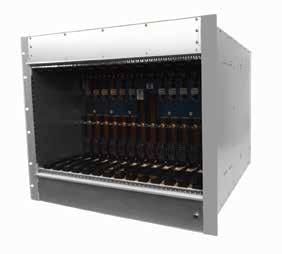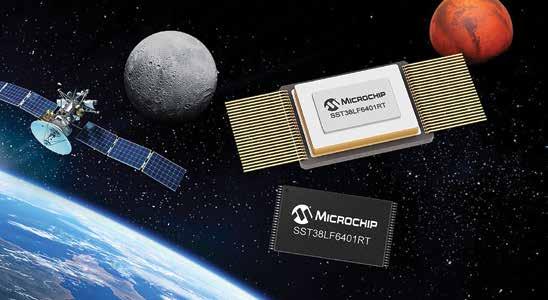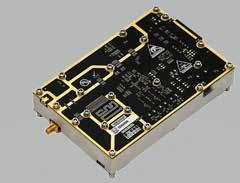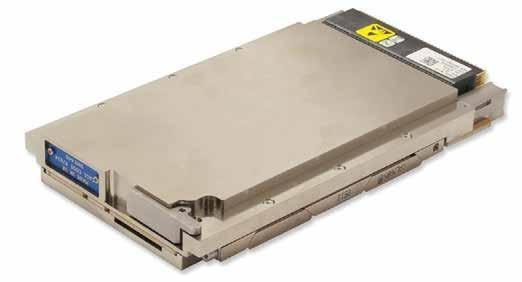
14 minute read
Editor’s Choice for January
January 2021 COT’S PICKS
Kaman KD-5600 Family of Digital Differential Measuring Systems Ideal for Wide Range of Applications
The Measuring Division of Kaman Precision Products, Inc., announces that the KD-5600 family of digital eddy current measurement systems are ideal for use in COTS applications for fast steering mirrors, magnetic bearing active control, shaft vibration, image stabilization, and adaptive optics.
Customers in the small satellite, semi-conductors, military/aerospace, high precision metalworking, and UAV/drone sectors benefit from the KD-5600 system’s host of features. Designed for non-contact linear position displacement sensing applications, Kaman released two configurations for tailored use. The KD5656 (Full System) and KD-5690 FE (Front-End) are equipped with custom sensors, signal processing, analog to digital converter, and a custom calibration system to ensure precision and accuracy.
For optimum operation for each channel, the KD-5600 system has two matched sensors. Input signals are filtered and SWaP-C scaled to provide optimum operation, remove common mode noise, and deliver a drive signal. They also provide digital filtering as part of the signal conditioning to reduce signal noise.
The suite of products is designed with high resolution, bandwidth, and linearity and equipped with a Serial Peripheral Interface Bus for fast data transfers and no firmware. Additionally, the KD-5600 system samples data at eight times the standard data rate. Oversampling at high volume provides higher resolution at the defined data rate, which results in a signal resolution that is eight times better than a system sampling at the Nyquist rate.
Using a 9D connector for reading data, power, and control signals, the system operates from a single power supply with a voltage range of 8-28 volts. These features combined ensure long-term stability.
Kaman Precision Products, Inc. www.kamansensors.com
Acromag Releases the Smallest Mezzanine Module with the Power of a Zynq® UltraScale+™ MPSoC for I/O Processing and Programmable Logic
This new AcroPack® module combines multicore ARM processors, FPGA capabilities, and I/O interfaces on a rugged, high-density platform for embedded computing applications
Acromag’s new APZU series expands their offering of mini PCIe-based AcroPack modules with a programmable I/O solution featuring the Xilinx® Zynq UltraScale+ multiprocessor systemon-a-chip (MPSoC). Three models are available offering a choice of digital I/O interfaces with 28 TTL, 20 TTL, and 3 RS422/485, or 14 LVDS signals. These mezzanine modules mount on a variety of AcroPack carrier cards for PCIe, VPX, and other platforms allowing developers to mix and match I/O combinations on a single board for embedded applications running on Linux®, Windows®, or VxWorks® operating systems.
The APZU’s Zynq 3CG MPSoC combines a feature-rich ARM-based processing system and programmable logic in a single device. Two dual-core ARM Cortex CPUs (A53 application processor and R5 real-time processor) deliver high-performance computation capability. 154k logic cells provide plenty of FPGA processing blocks for hardware acceleration and compute-intensive tasks. Additional resources include large on-chip memory, external memory interfaces, and a rich set of peripheral connectivity interfaces. Gigabit Ethernet, USB 2.0, and USB-UART interfaces are supported.
AcroPack modules are only 30mm x 70mm. They use a standard mini PCIe edge connector but add a down-facing 100-pin connector which internally routes I/O signals through the carrier card to secure field connectors, thus eliminating loose cables and increasing reliability. More information about the AcroPack series is available from Acromag’s website at www.Acromag.com/AcroPacks.

“Designers can increase overall system performance by leveraging the tightly-coupled CPU and FPGA computing engines for different signal processing tasks in a very small and cost-effective form factor,” stated Robert Greenfield, Acromag’s Business Development Manager.
Designed for defense and aerospace systems, these AcroPacks are ideal for adaptive filtering, protocol conversion, simulation, HIL test, motor control, image processing, and sensor fusion applications. The COTS modules can be used in PCIe servers, VPX or CompactPCI Serial chassis, and small form factor embedded computers.
Acromag www.acromag.com
January 2021 COT’S PICKS
Pixus Develops OpenVPX Chassis Platform Supporting Speeds above 100GbE and 2500W of Cooling
Pixus Technologies has provided the fastest known customized OpenVPX backplane/ chassis design in the market.
The 9U RiCool chassis platform for 6U OpenVPX boards features dual hot-swappable 191 CFM fans for cooling up to 2500W. The design allows the use of Rear Transition Modules (RTMs) in all slots. Rear-pluggable PSU’s provide power for the VPX and custom rails, available in various wattage and output options.
The backplane design required routing for 28G+ signals across the backplane. This is more than the 4 x 25G speeds of 100GbE and the capability of the high-performance RT3 VPX connector. As such, a special high-speed connector was utilized for the 28G+ signals. The backplane also required VITA 66.5 and VITA 67.x interfaces for optical and RF through the printed circuit board.

Pixus offers high-performance OpenVPX and other open standard architecture backplanes, chassis platforms, and specialty products. The company also provides customizable faceplates, ejector handles, card guides, and other components.
Pixus Technologies https://pixustechnologies.com
Microchip Adds 64 Mbit Parallel SuperFlash® Memory to its Family of Radiation-Tolerant COTS-Based Devices for Space Systems
To reduce the time, cost, and risk of developing spaceflight-qualified systems, designers may start with Commercial-Off-The-Shelf (COTS) devices that can later be replaced by their space-qualified, radiation-tolerant equivalent parts available in plastic or ceramic packages featuring the same pinout distribution. Microchip Technology Inc. (Nasdaq: MCHP) today announced a radiation-tolerant, 64 Megabit (Mbit) parallel-interface SuperFlash memory device with unrivaled Total Ionizing Dose (TID) tolerance for maximum reliability and robustness in the harsh radiation environment of space missions. It is an ideal companion to Microchip’s space-ready microcontrollers (MCUs), microprocessors (MPUs), and Field Programmable Gate Arrays (FPGAs) that provide the building blocks for this scalable development model.
“The SST38LF6401RT SuperFlash device further strengthens our scalable approach to developing total space system solutions using our radiation-tolerant or radiation-hardened microprocessors and FPGAs,” said Bob Vampola, associate vice president of Microchip’s aerospace and defense business unit. “It offers the vital protection these space systems need for the most reliable digital processing where companion Flash memory is required to store the critical software code or bitstream that drives the complete system.”
Radiation-tolerant up to 50 kilorad (Krad) TID, even while the Flash is still biased and operating, the SST38LF6401RT device enables systems to operate in a broad range of space applications where they cannot afford any loss of code execution that could lead to severe defects and system loss. It is an ideal companion to Microchip’s SAMRH71 Arm® Cortex®-M7-based radiation-hardened SoC processor and can also be used with the company’s RT PolarFire® FPGAs to support in-flight system reconfiguration. The device has pinout distribution compatibility with its industrial version for an easy transition to the space-qualified plastic or ceramic versions at the Printed Circuit Board (PCB) level.

Development Tools and Availability
The SST38LF6401RT SuperFlash device is sampling now in a ceramic version and supported by an evaluation board and demonstration software, available upon request. Also available upon request is an FPGA flight programming reference case for combining the SuperFlash device with an FPGA and a SAMRH71 processor with supporting software. Voltage operation ranges from 3.0 to 3.6 volts (V).
Microchip’s COTS-to-Radiation-Tolerant Process
By selecting relevant devices from its proven automotive- or industrial-qualified product family and adding silicon process improvements, Microchip gives them enhanced protections that make them more immune to single-event latchup in heavy ion environments. The radiation performance of the slightly modified devices is fully characterized and supported by a dedicated radiation report for each functional block. The devices are used in applications ranging from launch vehicles and satellite constellations to space stations. Designers can begin system implementation with easy-to-source COTS devices before swapping them out with pinout-compatible space-qualified equivalents in high-reliability plastic or ceramic packages.
January 2021 COT’S PICKS
SOSA-Aligned WILDSTAR 3XR0 Board Integrates
Two Gen 3 RFSoCs and Enables 18+GHz Digitizationg
Annapolis Micro Systems has developed the first SOSA™-aligned 100Gb Ethernet FPGA board that combines the processing and A/D & D/A converting power of two Gen 3 Xilinx UltraScale+™ RFSoC FPGAs, with the ability to incorporate 18+GHz digitization.
The WILDSTAR™ 3XR0 3U OpenVPX FPGA Processor incorporates an innovative fulllength coax-connected Analog Interface Mezzanine Site. This site can be populated with a direct RF digitization mezzanine, or a 3rd party analog superheterodyne tuner to allow for the digitization of 18+GHz signals.
An integrated tuner delivers much lower SWaP-C than a separate standalone tuner while maintaining the ability to upgrade the tuner and digitizer/processor separately.

“We don’t know of anyone else who is combining this much tuning, digitizing, and processing capability in a single 1” VITA 48.1 slot,” said Noah Donaldson, Annapolis Micro Systems Chief Technology Officer.
In addition to two Gen 3 RFSoC FPGAs (XCZU43DR & some other P/Ns on request), an on-board Xilinx MPSoC (XCZU5EV) provides high performing yet low power self-hosting capability thanks to the power-efficient ARM cores.
The rugged 3XR0 supports wide temperature ranges via air, conduction (photo above), or air-flow-through cooling. Min/max operating temperatures are -55˚C/85˚C; min/max storage temperatures are -65˚C/105˚C.
For maximum flexibility, the 3XR0 supports SOSA and/or VITA 65 backplane slot profiles architectures. It also offers optional VITA 67 backplane RF connectivity.
Annapolis Micro Systems www.annapmicro.com

January 2021 COT’S PICKS
Boeing Satellites use RadiationTolerant Power Modules from Vicor
Tested and proven resiliency to 50 kilorad of total ionizing dose and immune to single-event upsets
Vicor announced the launch of its first radiation-fault-tolerant DC-DC converter power modules, housed in the new Vicor plated SM-ChiP™ package. Capable of powering low-voltage ASICs of up to 300 watts from a 100V nominal power source, the ChiPs were tested by Boeing to be resilient to 50krad of total ionizing dose and immune to single-event upsets. Immunity to single-event upsets is achieved using a redundant architecture, where two identical and parallel powertrains with fault-tolerant control ICs are housed in a single high-density SM-ChiP package.
Advanced communication satellites require high power density and low noise. Vicor soft-switching, high-frequency ZCS/ZVS power stages within metal-shielded ChiPs, reduce the power system noise floor, enabling signal integrity and total system performance with the requisite high level of reliability.
The complete power-source-to-point-of-load solution consists of four SM-ChiPs: the BCM3423, a 100V nominal, 300 watts K = 1/3 bus converter in a 34 x 23mm package; the PRM2919, a 33V nominal 200W regulator in a 29 x 19mm package; and two VTM2919 current multipliers, a K = 1/32 with an output of 0.8V at 150A and a K = 1/8 with an output of 3.4V at 25 amps. The solution powers the ASIC directly from the 100V power source with minimal external components and low-noise operation.
All of the modules are available in the Vicor high-density SM-ChiP package with BGA (ball grid array) connections and an optional solder mask for the top and bottom surfaces. The operating temperature for the ChiPs is –30 to 125°C.
Vicor www.vicorpower.com

Vicor supports Boeing-manufactured O3b mPOWER satellite with first radiation-fault-tolerant DC-DC converter power modules, housed in the new Vicor plated SM-ChiP™ package (image credit: SES)

January 2021 COT’S PICKS
VHF Data Exchange System Module
RFMW announces design and sales support for a VHF Data Exchange System Module from CML Microcircuits. The VDES1000 module is a complete marine VHF Data Exchange System (VDES) Software Defined Radio (SDR) solution. Implemented using state-of-theart technology provides a very tight integration, with industry-leading high performance and unsurpassed flexibility in a very small form factor. The module provides out-of-the-box high performance, a fully compliant multi-channel AIS Class-A, ASM, VDE transceiver, and is highly flexible. The VDES1000 module integrates an isolated power supply, high power amplifier, Low Noise Amplifier (LNA), digital baseband processing, and protocol handler for AIS, ASM, and VDE and is designed for easy addition to existing housing, enabling a speedy development cycle to end product. Future proof to accommodate evolving VHF Data Exchange System standards, the module is fully upgradeable via software updates.
RFMW Ltd. www.rfmw.com

Abaco Systems First 3U VPX Ethernet Switch with Alignment to SOSA™ Technical Standard
Abaco Systems, Inc. announces the SWE440S, an upgrade that builds on the strong capability and high performance of our SWE440A, with one of the most capable and flexible 3U VPX switches on the market. This fully managed Ethernet switch is designed to align with the SOSA™ Technical Standard, and also continues to be the most capable solution for customers who are not seeking alignment to this standard. By keeping power low and functionality high – the SWE440S provides greater interoperability and integration with SBCs, FPGAs, and Ethernet switches while providing cost reduction for our customers.
Customer feedback and use cases, combined with the need for alignment with the SOSA™ Technical Standards, drove our engineers’ innovation process and shaped the SWE440S into a product that delivers exactly what our customers need. For applications that require 3U technology and alignment with the SOSA Technical Standard, the SWE440S, VP431, and SBC3511 provide a complete portfolio of products where interoperability has been designed – reducing risk for customers. With SoC switch fabric at the core of our design, this is a market-leading product for port flexibility with options for the type of management interface (LVCMOS or RS232), as well as offering two 10G capable SFP+ cages to the front panel for optical connectivity. Abaco can deliver a flexible solution that will meet the requirements of applications in the defense and commercial markets.
The SWE440S comes with our latest version of OpenWare 6.4.0 and can be configured quickly and easily. We are carrying forward the port wizard capabilities of the SWE440A so that the SWE440S can be reconfigured using OpenWare for quantities of 1G, 10G, or 40G ports. This innovative solution makes the SWE440S ideal as a futureproof solution. For instance, if a customer is running at 10G presently, but wants to make the jump to 40G in the future – the SWE440S is up for the challenge. This will be useful for customers looking for a managed Ethernet switch for use with radar, surveillance, situational awareness, imaging, AI and autonomy, rugged industrial and transportation, and other high-performance embedded computing applications.

Pete Thompson, VP of product management for Abaco Systems, Inc. said, “As the SOSA™ Technical Standard drives the industry towards alignment, we are forging ahead with innovative solutions to stand by our customers as they transition – giving them the most comprehensive portfolio of 3U VPX products that are aligned to the SOSA Technical Standard. Simultaneously, we can offer the best solutions available for customers who are not seeking a product that has been aligned to the SOSA™ technical standard. By continuously improving our offerings, Abaco can deliver new products which will meet the needs of our customers and allow them to succeed by creating the most capable solutions.”
Technical Overview
The NETernity™ SWE440S is a fully managed (Layer 2/3)3U VPX Ethernet switch. It is designed to align with the SOSA™ Technical Standard. For customers who are not seeking alignment to this standard, a full-featured variant of the SWE440S with more I/O is available to provide a robust insertion/upgrade solution for users of the SWE440A. Various OpenVPX profiles including MOD3-SWH-6F8U-16.4.10-n and MOD3-SWH6F6U-16.4.1-n. s. Up to 32 10GigE or 8 40GigE ports (or combination of the two) plus up to 3 1GigE ports are supported. Rugged Levels 1 and 5 available. Supports connectivity and performance options for 40GBase-KX4, 10GBaseKR, 10GBase-KX4, and 1000BaseKX. Options for the type of management interface (LVCMOS or RS232), through to two 10G capable SFP+ cages to the front panel for added flexibility. The SWE440S is equipped with the latest version of OpenWare™ Switch Management Software which brings enhanced capabilities to an already industry-leading switch.
COTSCOTS
ADVERTISERS
Company Page # Website
Alphi Technology Corporation .................................. 24 ........................................... www.AlphiTech.com Annapolis Micro Systems ........................................ 21 ........................................ www.annapmicro.com Fairview Microwave ................................................ IBC ............................. www.fairviewmicrowave.com Great River Technology ......................................... 13 ..................................... www.greatrivertech.com MPL ...................................................................... 21 ..................................................... www.mpl.com Neonode ................................................................. 16 ............................................. www.neonode.com OSS ........................................................................ IFC/BC .................................. www.onestopsystems.com Pentek .................................................................. 5 ................................................. www.pentek.com PICO Electronics, Inc ............................................. 11 ................................... www.picoelectronics.com Pixus Technologies ................................................. IBC .............................. www.pixustechnologies.com Sealevel ................................................................. 28 .............................................. www.sealevel.com SECO ...................................................................... 4 .............................................. www.seco.com/en Versalogic .............................................................. 25 ........................................... www.versalogic.com
COTS Journal (ISSN#1526-4653) is published monthly at; 3180 Sitio Sendero, Carlsbad, CA. 92009. Periodicals Class postage paid at San Clemente and additional mailing offices. POSTMASTER: Send address changes to COTS Journal, 3180 Sitio Sendero, Carlsbad, CA. 92009.




